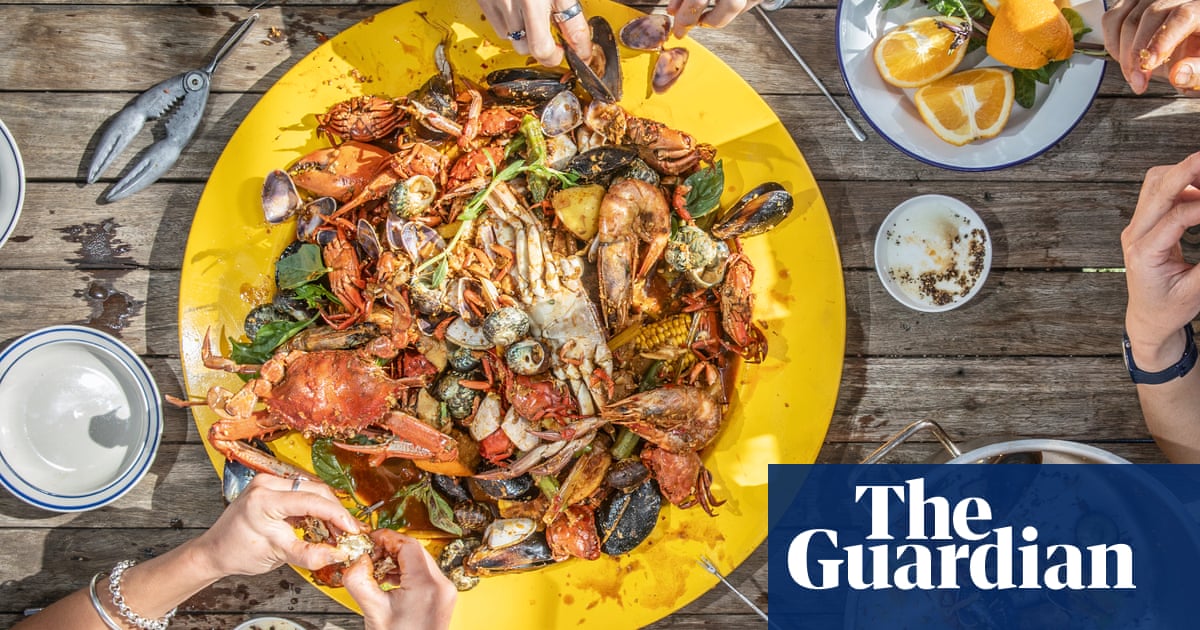Mum has told me a few iterations of how she ended up in Australia: one was because my biological father had been sent to Australia rather than the US after leaving the refugee camp; another because she heard Australia was a much nicer place. Either way, while my cousins made it to the US to meet up with the other relatives, Mum found her way into Australia.
This dish takes inspiration from my cousins in the US. It’s the ultimateviet kieu(which translates to “overseas Vietnamese”) story – migrants and naturalised Vietnamese forced to find a living in a new area, then adapting a local dish by amping it up with Vietnamese condiments: lemongrass, orange wedges, spring onion oil, ginger, butter,muối tiêu chanh(salt, pepper and citrus). The practice of boil-ups is hardly foreign to generations of Vietnamese regardless of location – fresh seafood hauled on to land, boiled, seasoned and enjoyed with lots of beer and a healthy dose of shit-talking.
This recipe should give you the starting point for your own Viet-Cajun party. The beauty of Australia is the seafood – instead of crawfish, as you’d expect in the US, we have used prawns, mussels, shore crabs, calamari, fish and mud crabs. But you can use any combination of seafood here – just aim for a combined weight of 2.5-3kg.
Sign up for the fun stuff with our rundown of must-reads, pop culture and tips for the weekend, every Saturday morning
For side dishes, you can add corn doused in spring onion oil, collard greens, okra and blanched beans, as well as egg noodles and bread to soak it all up.
It’s a dish best enjoyed in a grassy back yard. Historically, we have tipped everything on to a table, hoed into the lot, and proceeded to hose down the entire table after a quick clean-up.
Serves6–8500g periwinkles500g pipis, or clams of your choice1-2 bullet, bird’s eye or green scud chillies, roughly chopped, to purge the clams2 blue swimmer crabs, or dungeness or jonah crabs, halved straight down the middle500g tiger prawns500g yabbies(crayfish)500g mussels, beards removed250g new potatoes2 corn cobs, cut into 5cm pieces, husks reserved for the broth250g okra1 bunch Thai basil
For the spice mix:100g hot or smoked paprika60g cayenne pepper60g lemongrass powder60g ground ginger60g onion powder60g garlic powder20g Chinese five spice30g fennel seeds, blitzed or crushed1 green cardamom pod, crushed20g sea salt10g granulated white sugar
Store leftover spice mix in an airtight container.
For the broth:3 litres chicken stock2 cups (500ml) coconut water(no added sugar, if using a packaged version)2 corn husks, tied8 oranges, juiced, skin reserved150g ginger, peeled and chopped2 lemongrass stems, cut into 5cm lengths1 onion, quartered1 garlic bulb, halved8 fresh bay leaves6 star anise1 cassia bark stick
For the sauce:50ml vegetable oil75g garlic, peeled50g ginger, peeled and roughly chopped50g lemongrass, very finely chopped25g red bird’s eye chillies, very finely chopped125g unsalted butter50ml fish sauce
To serve:1 orange, juicedsalt, pepper and citrusorhot sauce
Sign up toSaved for Later
Catch up on the fun stuff with Guardian Australia's culture and lifestyle rundown of pop culture, trends and tips
after newsletter promotion
Combine all the spice mix ingredients in a bowl, mixing well.
Place all the broth ingredients – including the orange skins – in a stockpot, along with 100g of the spice mix. Bring to the boil and leave to infuse over low heat for 30 minutes.
Clean the seafood, depending on the types you have selected. If using periwinkles and/or pipis that are not labelled “pot ready”, purge them of sand by leaving them to soak in a bowl of cold water with two chopped chillies for at least one hour. The oils in the chillies stimulate bivalves to expel their sand. If using crabs, turn them over, pry off and remove the belly plate, and chop the body in half with a cleaver. If using prawns, you can remove the shells and intestinal tract. I like to keep the heads on for extra flavour during cooking.
Rinse all the seafood under cold running water and leave to drain.
To cook the seafood and vegetables, bring the stock back to the boil with the lid on. Add the crab, periwinkles, potatoes, corn and Thai basil to the stock and cook rapidly for 10 minutes, covered. Add the okra, pipis, prawns, yabbies and mussels and cook for a further five minutes, covered.
While the seafood is simmering, heat the oil in a large wok over high heat. Add the garlic, ginger, lemongrass and chilli and fry for one minute. Add the butter and let it melt. Bring to a bubble and stir in the fish sauce and 150g of the spice mix. Check the seasoning; the sauce should be spicy and buttery, with a hint of sweetness on the back palate. Once you are happy, turn off the heat.
Once the seafood is cooked, scoop it out of the broth and add it to the wok. Give the seafood a good toss to ensure it is evenly coated in the sauce. Check the seasoning, and add more spice blend to your liking.
Stir the additional orange juice through the seafood to lighten the sauce. Toss in a good handful of Thai basil leaves, then empty the contents of the wok into a large vessel, like a paella pan, or straight on to a table covered in plastic wrap.
Serve with salt, pepper and citrus, or your favourite hot sauce.
This is an edited extract from Viet Kieu by Thi Le with Jia-Yen Lee, photography by Mark Chew. (Murdoch Books, RRP A$55)
